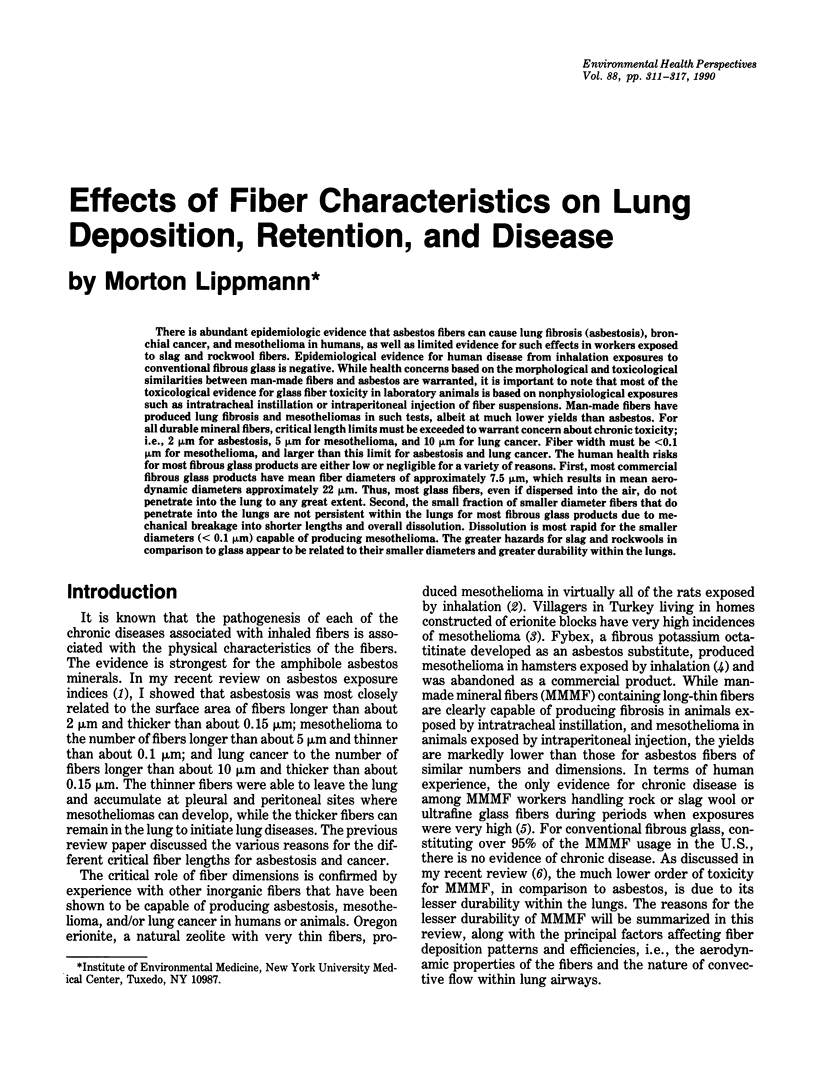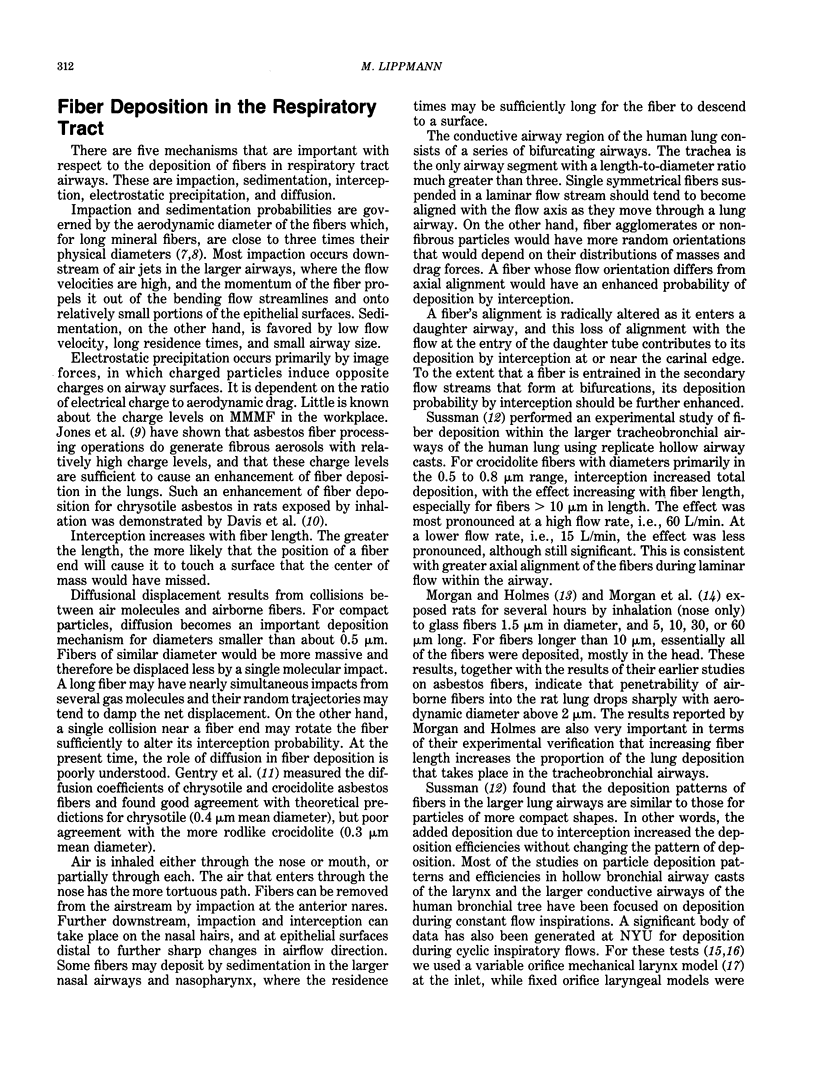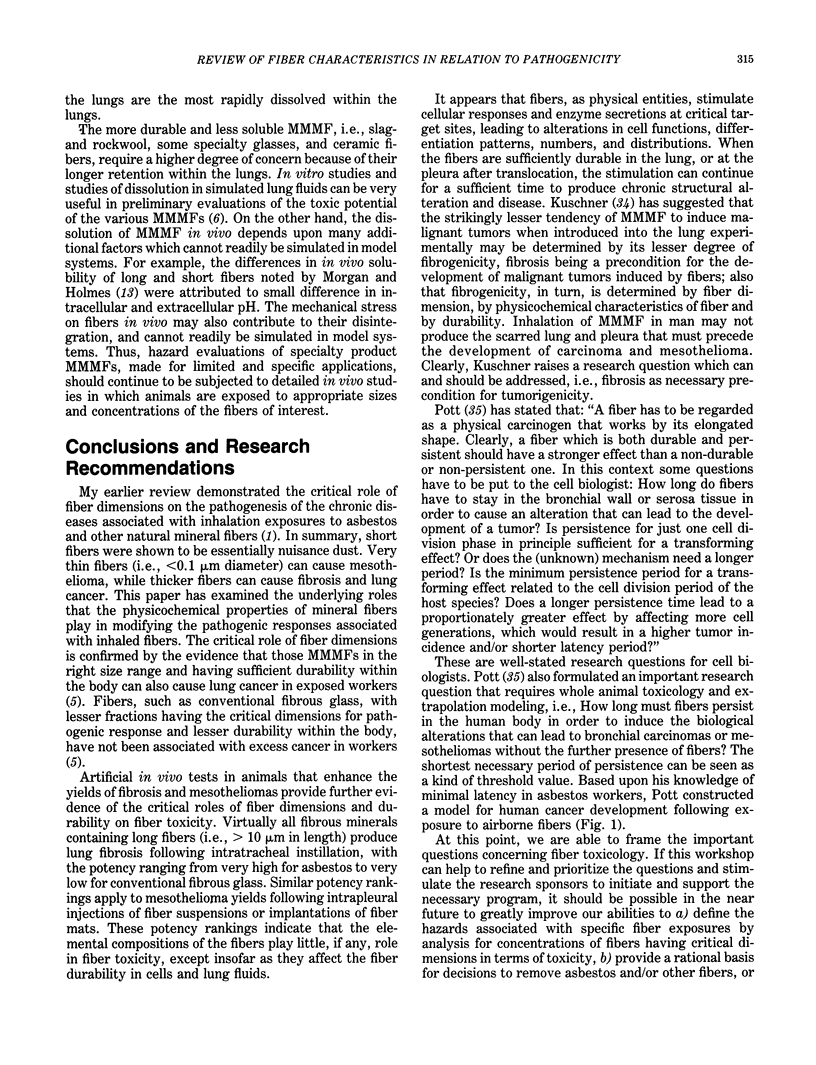Abstract
There is abundant epidemiologic evidence that asbestos fibers can cause lung fibrosis (asbestosis), bronchial cancer, and mesothelioma in humans, as well as limited evidence for such effects in workers exposed to slag and rockwool fibers. Epidemiological evidence for human disease from inhalation exposures to conventional fibrous glass is negative. While health concerns based on the morphological and toxicological similarities between man-made fibers and asbestos are warranted, it is important to note that most of the toxicological evidence for glass fiber toxicity in laboratory animals is based on nonphysiological exposures such as intratracheal instillation or intraperitoneal injection of fiber suspensions. Man-made fibers have produced lung fibrosis and mesotheliomas in such tests, albeit at much lower yields than asbestos. For all durable mineral fibers, critical length limits must be exceeded to warrant concern about chronic toxicity; i.e., 2 microns for asbestosis, 5 microns for mesothelioma, and 10 microns for lung cancer. Fiber width must be less than 0.1 microns for mesothelioma, and larger than this limit for asbestosis and lung cancer. The human health risks for most fibrous glass products are either low or negligible for a variety of reasons. First, most commercial fibrous glass products have mean fiber diameters of approximately 7.5 microns, which results in mean aero-dynamic diameters approximately 22 microns. Thus, most glass fibers, even if dispersed into the air, do not penetrate into the lung to any great extent. Second, the small fraction of smaller diameter fibers that do penetrate into the lungs are not persistent within the lungs for most fibrous glass products due to mechanical breakage into shorter lengths and overall dissolution.(ABSTRACT TRUNCATED AT 250 WORDS)
Full text
PDF






Selected References
These references are in PubMed. This may not be the complete list of references from this article.
- Baris I., Simonato L., Artvinli M., Pooley F., Saracci R., Skidmore J., Wagner C. Epidemiological and environmental evidence of the health effects of exposure to erionite fibres: a four-year study in the Cappadocian region of Turkey. Int J Cancer. 1987 Jan 15;39(1):10–17. doi: 10.1002/ijc.2910390104. [DOI] [PubMed] [Google Scholar]
- Bellmann B., Muhle H., Pott F., König H., Klöppel H., Spurny K. Persistence of man-made mineral fibres (MMMF) and asbestos in rat lungs. Ann Occup Hyg. 1987;31(4B):693–709. doi: 10.1093/annhyg/31.4b.693. [DOI] [PubMed] [Google Scholar]
- Brody A. R., Hill L. H., Adkins B., Jr, O'Connor R. W. Chrysotile asbestos inhalation in rats: deposition pattern and reaction of alveolar epithelium and pulmonary macrophages. Am Rev Respir Dis. 1981 Jun;123(6):670–679. doi: 10.1164/arrd.1981.123.6.670. [DOI] [PubMed] [Google Scholar]
- Brody A. R., Roe M. W. Deposition pattern of inorganic particles at the alveolar level in the lungs of rats and mice. Am Rev Respir Dis. 1983 Oct;128(4):724–729. doi: 10.1164/arrd.1983.128.4.724. [DOI] [PubMed] [Google Scholar]
- Doll R. Symposium on MMMF, Copenhagen, October 1986: overview and conclusions. Ann Occup Hyg. 1987;31(4B):805–819. doi: 10.1093/annhyg/31.4b.805. [DOI] [PubMed] [Google Scholar]
- Gurman J. L., Schlesinger R. B., Lippmann M. A variable-opening mechanical larynx for use in aerosol deposition studies. Am Ind Hyg Assoc J. 1980 Sep;41(9):678–680. doi: 10.1080/15298668091425491. [DOI] [PubMed] [Google Scholar]
- Holt P. F. Translocation of asbestos dust through the bronchiolar wall. Environ Res. 1982 Apr;27(2):255–260. doi: 10.1016/0013-9351(82)90080-9. [DOI] [PubMed] [Google Scholar]
- Kuschner M. The effects of MMMF on animal systems: some reflections on their pathogenesis. Ann Occup Hyg. 1987;31(4B):791–797. doi: 10.1093/annhyg/31.4b.791. [DOI] [PubMed] [Google Scholar]
- Lee K. P., Barras C. E., Griffith F. D., Waritz R. S., Lapin C. A. Comparative pulmonary responses to inhaled inorganic fibers with asbestos and fiberglass. Environ Res. 1981 Feb;24(1):167–191. doi: 10.1016/0013-9351(81)90143-2. [DOI] [PubMed] [Google Scholar]
- Lee K. P., Kelly D. P., Kennedy G. L., Jr Pulmonary response to inhaled Kevlar aramid synthetic fibers in rats. Toxicol Appl Pharmacol. 1983 Nov;71(2):242–253. doi: 10.1016/0041-008x(83)90341-1. [DOI] [PubMed] [Google Scholar]
- Lippmann M. Asbestos exposure indices. Environ Res. 1988 Jun;46(1):86–106. doi: 10.1016/s0013-9351(88)80061-6. [DOI] [PubMed] [Google Scholar]
- Morgan A., Black A., Evans N., Holmes A., Pritchard J. N. Deposition of sized glass fibres in the respiratory tract of the rat. Ann Occup Hyg. 1980;23(4):353–366. doi: 10.1093/annhyg/23.4.353. [DOI] [PubMed] [Google Scholar]
- Morgan A., Holmes A., Davison W. Clearance of sized glass fibres from the rat lung and their solubility in vivo. Ann Occup Hyg. 1982;25(3):317–331. doi: 10.1093/annhyg/25.3.317. [DOI] [PubMed] [Google Scholar]
- Pott F. Problems in defining carcinogenic fibres. Ann Occup Hyg. 1987;31(4B):799–802. doi: 10.1093/annhyg/31.4b.799. [DOI] [PubMed] [Google Scholar]
- Roggli V. L., George M. H., Brody A. R. Clearance and dimensional changes of crocidolite asbestos fibers isolated from lungs of rats following short-term exposure. Environ Res. 1987 Feb;42(1):94–105. doi: 10.1016/s0013-9351(87)80010-5. [DOI] [PubMed] [Google Scholar]
- Schlesinger R. B., Lippmann M. Selective particle deposition and bronchogenic carcinoma. Environ Res. 1978 Jun;15(3):424–431. doi: 10.1016/0013-9351(78)90123-8. [DOI] [PubMed] [Google Scholar]
- Wagner J. C., Skidmore J. W., Hill R. J., Griffiths D. M. Erionite exposure and mesotheliomas in rats. Br J Cancer. 1985 May;51(5):727–730. doi: 10.1038/bjc.1985.108. [DOI] [PMC free article] [PubMed] [Google Scholar]


